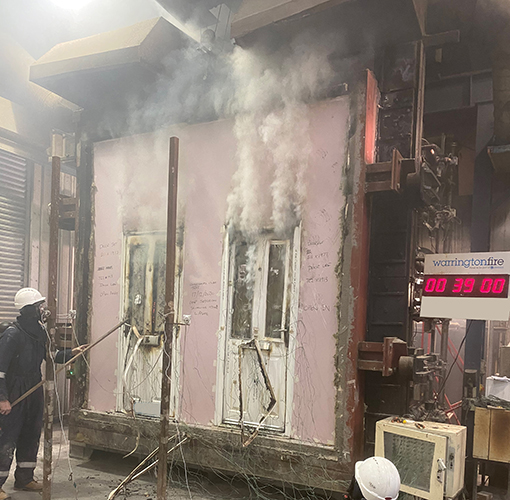Composite Entrance Doors
Legacy Doorsets pre-2018
Following the tragic events on 14th June 2017 at Grenfell Tower and the fire tests initiated by the Metropolitan Police investigation, the Ministry of Housing, Communities and Local Government (MHCLG) embarked on a series of fire tests of replacement composite fire doors manufactured by the same company as those installed in Grenfell Tower that were removed from existing sites and fire testing of newly manufactured fire doors from a variety of manufacturers. These tests were conducted in accordance with BS 476-22:1987 and the results did show an inconsistency in the length of time the doors demonstrated integrity, the requirement being 30 minutes.
MHCLG also identified that testing of composite fire doors, as with fire doors manufactured from other materials (timber etc.), were generally only tested with the doorset installed in the furnace in an ‘open-in’ orientation. Approved Document B Volume 2 – Buildings other than dwellinghouses – 2006 edition incorporating 2007, 2010 and 2013 amendments, Annex B, Clause 1, paragraph 3 states ‘The requirement is for test exposure from each side of the door separately, ……’ and therefore MHCLG stated that Fire Door manufacturers were not complying with the requirements of the Building Regulation guidance.
Composite doorset manufacturers did not take the decision to only test from one side themselves but were guided by the test houses and certification bodies who were considered to be the experts in the requirements for testing fire doors. Their decision was based on BS 476-22:1987, Clauses 6.2.1, 7.2.1 and 8.2.1 where the test houses believed they were clearly able to identify the weakest direction. They believed that a composite doorset mounted in an ‘open-in’ orientation was the weakest direction and therefore single sided testing was allowed in accordance with these clauses from BS 476-22:1987.
Following the MHCLG testing programs, the ACDM engaged with the Building Safety team at MHCLG to address 3 issues:
- How to prevent further fire doors being installed that did not meet the requirement of fire testing from both sides. ACDM members agreed to withdraw composite fire doors from the market until testing from both sides provided consistent evidence of performance.
- Extensive testing of composite fire doors has taken place in late 2018 through 2020 and is still on-going.
- ACDM has introduced a requirement that all members should hold independent third-party certification for their fire-resistant composite doorsets.
- How to address the potential issues with ‘legacy’ fire doors, i.e., the many 100s of thousands of composite fire doors already installed as flat entrance doors in England.
- The ACDM have worked with MHCLG to develop a suitable process based on fire safety as detailed in the LGA guide ‘Fire Safety in Purpose Built Blocks of Flats’.
- Following the Secretary of State’s statement to the House of Commons on 20th January 2020, MHCLG published the following documents:
- Advice for Building Owners of Multi-storey, Multi-occupied Residential Buildings:
- Annex A – Advice for Building Owners on assurance and assessment of flat entrance fire doors:
- The ACDM have produced a guide to the interpretation of the two MHCLG documents:
- Final fire webpages\TG 003 – ACDM interpretation of Building Regulations and Annex A requirements for Composite Fire-resistant Doorsets.docx
- How to get composite fire doors back to the market that can demonstrate the required performance from both sides.
- It was agreed that all composite fire doors to be installed in England should have test reports demonstrating that the doors provide the required integrity for fire-resistance, when tested from both sides.
- The requirements for new replacement fire doors are contained in Annex A above.
- Since late summer in 2018 extensive testing of Composite Fire Doors has taken place and Composite Fire Doorset manufacturers are now able to provide the two-sided test evidence required in the latest revision of Approved Document B.
- The ACDM has also introduced, as an additional requirement to AD B, that those members manufacturing fire doorsets are to also hold independent third-party certification through a UKAS or equivalent accredited body.
Based on the testing carried out from 2018 to present and the new composite fire-resistant doorset third party certification schemes introduced, specifiers can have confidence in the ability of composite doorsets to provide the protection required to comply with current Building Regulation requirements.

